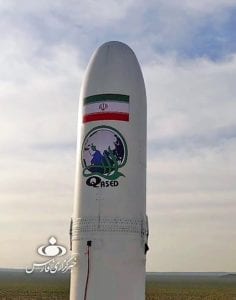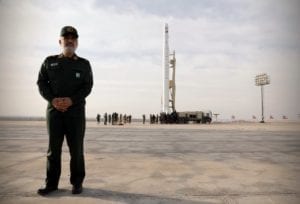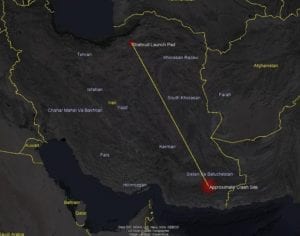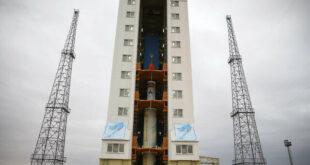
Iran’s Islamic Revolutionary Guard Corps (IRGC) announced that it had launched a military satellite on the morning (Iranian time) of 22 April 2020 on board a previously unknown satellite launch vehicle the IRGC calls Qassed.
The military satellite, called Noor (also spelled ‘Nur’ and ‘Nour’ – Farsi for ‘Light’), could be an Earth observation satellite or some other kind of intelligence gathering system. If Noor is an Earth observation satellite its resolution and capability is likely to be limited. In any case, the IRGC satellite reached its intended 425 kilometre altitude in a Sun-synchronous orbit (SSO).
Speaking to the Tasnim and Fars news agencies, Major General Hossein Salami, the head of the IRGC, said, “We have made a leap in the field of expanding territory and strategic intelligence….Today, we can see the world from space, and this means expanding the strategic intelligence of the powerful defense force of the Islamic Revolutionary Guard Corps…The deployment of this multi-purpose satellite in space, both in the field of information technology and intelligence battles, can produce strategic added value for us, and in intelligence warfare, it creates powerful grounds for us.”
“Today, the world’s powerful armies do not have a comprehensive defense plan without being in space, and achieving this superior technology that takes us into space and expands the realm of our abilities is a strategic achievement,” Salami added.
It has been rumoured for sometime that Iran would like to acquire or build and then launch a high resolution reconnaissance satellite. Noor is very unlikely to be that satellite given the relatively small size of the Qassed SLV, and as a result it – if it is an Earth observation satellite – has a low resolution in the tens of meters. There is a possibility, however, that Noor is a technology demonstrator or some other kind of testbed for a more capable satellite in the future.
“We now form the front lines of technological talents…the launch of the satellite is not limited to defense and military issues, adding that the realization of this important goal will lead the country to great progress in various fields, so it is a strategic achievement for our Islamic system,” said Salami.

Perhaps the biggest surprise of the Noor satellite launch is the use of the Qassed (Farsi for ‘Messenger’) satellite launch vehicle, an SLV that has not been seen or heard of before in open sources. The Qassed is a three-stage launch vehicle that, according to the IRGC, uses a combination of liquid and solid-fueled stages. Additionally, the Qassed is launched from a transporter erector launcher (TEL) vehicle, giving the SLV a mobile launch capacity.
An image from the U.S. Government shows that the Qassed SLV was launched in a southerly direction from its launch pad in Northern Iran placing the Noor satellite into a Sun-synchronous orbit (SSO). An SSO orbit lends further credence to speculation that Noor is an Earth observation satellite as the orbit will allow it to pass over every part of Earth several times a day for the duration of its (unknown) operational lifetime.

Furthermore, it appears that the Qassed SLV with the Noor satellite was launched from a base that has never been previously used for satellite launches in Iran. Until now all Iranian satellite launches have been conducted from the Imam Khomeini Space Centre in the Semnan province in Eastern Iran. The 22 April 2020 launch, however, was carried from an IRGC base located in the Shahroud area in Northern Iran.
There could be several reasons for this, not least because the Imam Khomeini Space Centre is the launch base for Iran’s civil space programme. The Shahroud base could be the IRGC’s military satellite launch centre located near the Caspian Sea.
Another reason for launching from Shahroud could have been to deceive reconnaissance satellite from countries such as the United States and France that would have been specifically watching the Imam Khomeini Space Centre for activity.
Later on 22 April 2020 video emerged online purporting to show damaged rocket parts on the ground in what appears to be the Sistan and Balochistan province of Iran.
In an email to SpaceWatch.Global, USSPACECOM spokesperson Lt. Col. Christina Hoggatt said, “U.S. Space Command is tracking two objects associated with a space launch that originated from Iran. The objects are being analyzed and once confirmed will be incorporated into a publicly available space catalogue on www.space-track.org for Space Domain Awareness and conjunction warnings to support space flight safety.”
While much is unknown about the launch and its payload at the time of publication, what is apparent is that Iran now has two space programs. The first is ostensibly run by the Iran Space Agency (ISA) and has been known about and reported on for years. The second space programme is military in nature, run by the IRGC, and was unveiled on 22 April 2020.
The Islamic Republic News Agency (IRNA) posted a video of the Noor launch on YouTube:
 SpaceWatch.Global An independent perspective on space
SpaceWatch.Global An independent perspective on space




